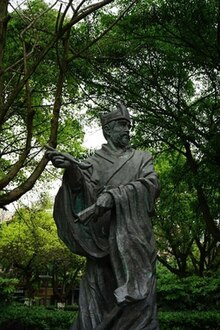
Summary
Chang Qu (291–361), courtesy name Daojiang, was a Chinese historian of the Cheng-Han dynasty during the Sixteen Kingdoms period and the Jin dynasty (266–420). Chang Qu is best known for his magnum opus, the Chronicles of Huayang or Records of the States South of Mount Hua that he compiled between 348 and 354, the oldest extant regional history of China about his native region of Sichuan.
Chang Qu | |
|---|---|
| 常璩 | |
 Statue of Chang Qu | |
| Cavalier In Regular Attendance (散騎常侍) | |
| In office ?–347 | |
| Monarch | Li Shi |
| Personal details | |
| Born | 291 Chengdu, Sichuan |
| Died | 361 (aged 70) Sichuan |
| Relations | |
| Occupation | Historian |
| Courtesy name | Daojiang (道將) |
Life edit
Chang Qu was born in Jiangyuan, Shu Commandery (蜀郡), which is in present-day Chengdu, Sichuan during the Jin dynasty. The Chang of Jiangyuan were a prominent clan producing many scholars and masters of the prose who enjoyed writing. At the start of the 4th century, due to a peasant uprising in the Shu region, local nobles led their followers and retainers to migrate far away. The Chang clan led by Chang Kuan (常寬) went east to Jing and Xiang, following the path of Du Tao and others. At this time, Chang Qu was still a child, born from a minor and poor branch of the Chang therefore his household was unable to migrate. They joined another clan and took refuge with Fan Changsheng of Qingcheng to survive. Later, they received the protection of Li Xiong.[1]
After Li Xiong gained control of Liang and Yi, he greatly promoted education and culture. The Shu region was peaceful at the time, the harvest was abundant and taxes were light. Chang Qu, as a remnant of the Chang ancient and noble family grew up in this stable environment, having the chance to read widely among the books left by his ancestors and took great pride in his literary abilities.[2]
Meanwhile, the Shu people who had migrated to Jing and Xiang were ruled by Du Tao, who had established control over the region. Chang Kuan led the Chang clan to escape via the region of Jiaozhi. When Li Xiong conquered Ningzhou,[b] he summoned back the displaced people. The Shu people who had migrated to Jiaozhi, Nanzhong and Jing/Xiang gradually returned, including members of the Chang. At this time, Chang Qu was starting his official career and the newly returned Chang relatives all relied on him.[3]
Chang Qu was studious and curious, among the returned migrants many had knowledge of far-off places and tales of turmoil. With this wealth of information, Chang Qu wrote extensively. During the reigns of Li Qi and Li Shou, Chang Qu continued to serve as a historian. He used the maps and records from the time of Li Xiong to write the Geographical Records of Liang, Yi and Ning Three States (梁益宁三州地志) and the Book of Shu Han (蜀漢書). Li Shou had cut off connections with the regions south of the Yangtze River but still had contacts with the north, as a result, Chang Qu's books were among the first to circulate in the Yellow River region.[4]
During the reign of Li Shi, Chang Qu served as Cavalier In Regular Attendance (散騎常侍), he respected the views of Gong Zhuang (龔壯) of Baxi and favored the regions south of the Yangtze River. In the third year of Yonghe (347), when Huan Wen invaded Shu and his army reached Chengdu, Chang Qu, along with the Supervisor of the Palace Writers (中書監) Wang Wei (王嘏), advised Li Shi to surrender to Jin, and then moved with him to Jiankang. The people of the south of the Yangtze River valued the old families of the Central Plains and looked down on the people of Shu. At this time, Chang Qu was already old and filled with indignation. He stopped pursuing further official positions, revised his previous works and compiled them into the Chronicles of Huayang.[5]
The main purpose of his work was to promote the long history of the Ba and Shu regions, to describe their historical figures as to reaffirm their own culture over the hegemony of the Central Plains and northern people while resisting the criticisms from other southern regions. Because the materials were unprocessed, the narrative was legitimated and the writing was elegant and concise. During his time, it received praises from scholars and erudites rendering it popular among his contemporaries. Since then, it has been adopted as the model to follow by regional historians for a thousand years.[6]
Notes edit
- ^ Chang Kuan (常寬) has his own biography in Volume 11 of the Huayang Guo Zhi.
- ^ Nanzhong was also called Ningzhou or Ning Province (寧州).
References edit
- ^ (常璩字道将,晋世蜀郡江原县人。江原常氏为巨族,颇多治学艺、擅文辞、喜着述者。四世纪初,因蜀地农民起义,当地士族纷率其部曲客户流转远徙他乡。常氏以常宽为首领,从杜弢等东走荆湘。璩时尚幼,家较贫,未能远徙,随族结□,附青城范长生以自存。后受李雄绥抚。) Huayang Guozhi School Supplementary Illustration
- ^ (雄既奄有梁益,颇兴文教。时则蜀土清晏,年丰赋薄,璩以旧族遗民,方当壮岁,在安定生活中,得遍读先世遗书,颇以文学自负。) Huayang Guozhi School Supplementary Illustration
- ^ (其后蜀民流在荆湘者,奉杜弢割据湘州,常宽复率族避地交址。李雄收取宁州,招辑流民,蜀人流在交址、南中、荆湘者,次第复还,常族与焉。时璩方强仕,常氏新还者咸依之。) Huayang Guozhi School Supplementary Illustration
- ^ (璩强学好问,招还流民中又多有识远方地理与乱离故事者,记问既丰,颇多撰述。逮李期、李寿之世,璩仍为史官。曾依李雄时图籍版档,撰《梁益宁三州地志》及《蜀汉书》。李寿与江左绝,而颇交通北方,璩书缘是最先流传黄河流域。) Huayang Guozhi School Supplementary Illustration
- ^ (李势时,璩官散骑常侍,素服巴西龚壮言论,倾心江左。永和三年,桓温伐蜀,军至成都,璩与中书监王嘏等劝势降晋,随势徙建康。江左重中原故族,轻蜀人,璩时已老,常怀亢愤,遂不复仕进,裒削旧作,改写成为《华阳国志》。) Huayang Guozhi School Supplementary Illustration
- ^ (其主旨在于夸诩巴蜀文化悠远,记述其历史人物,以颉颃中原,压倒扬越,以反抗江左士流之诮藐。因资料新颖,叙述有法,文词亦复典雅、庄严,符合封建士流志尚,故能及时流行,为千六百年来地方史志所取则。) Huayang Guozhi School Supplementary Illustration
- Ren Naiqiang. Huayang Guozhi School Supplementary Illustration.


